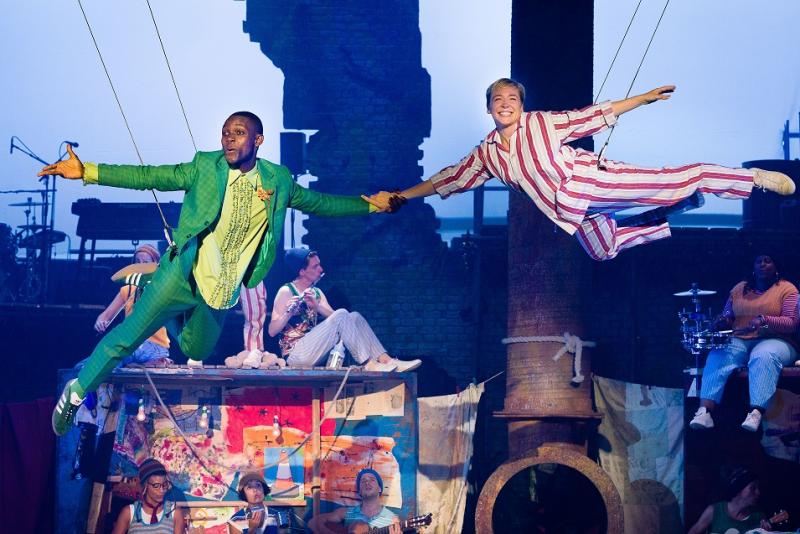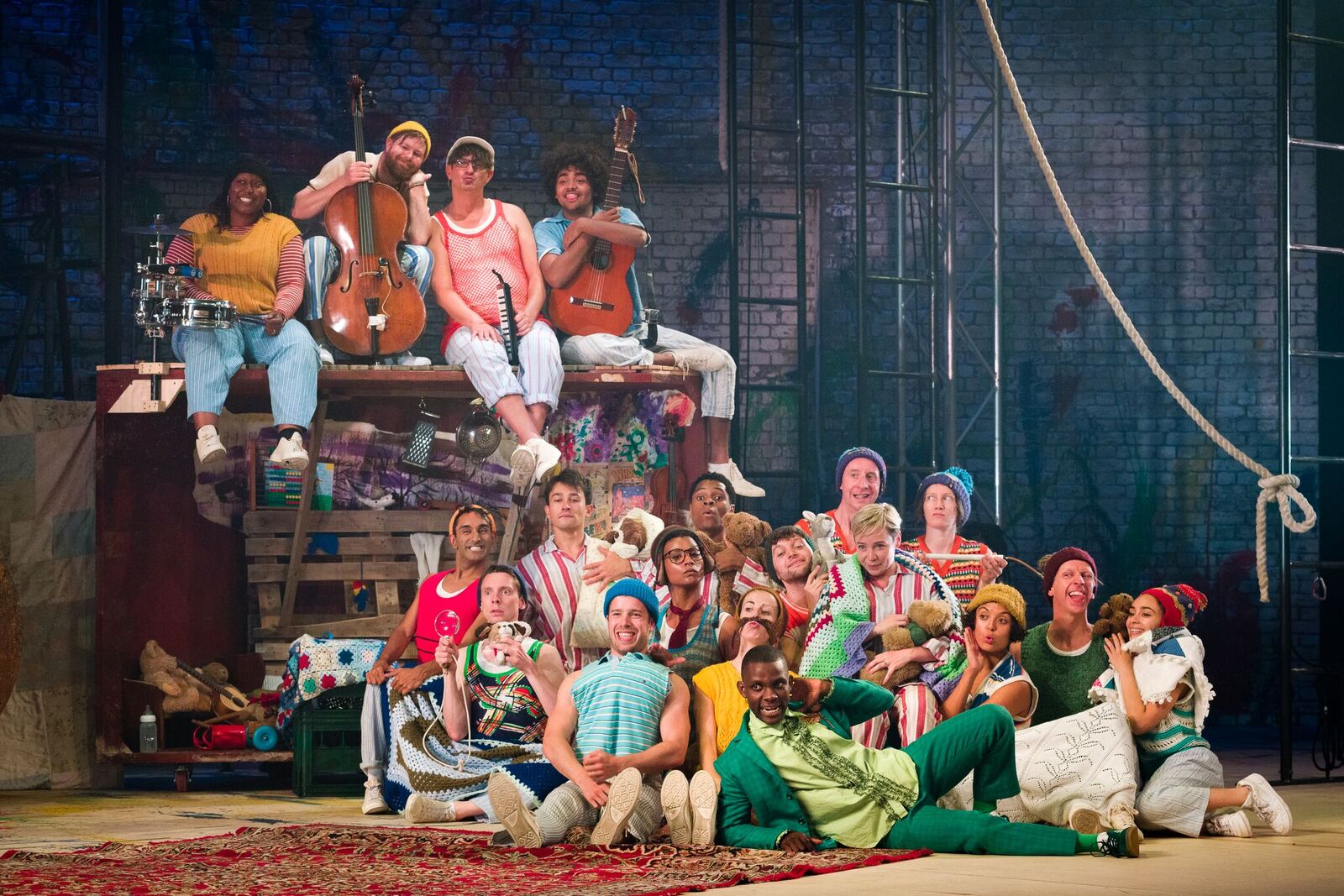Peter Pan, Troubadour White City review - off to a flying start | reviews, news & interviews
Peter Pan, Troubadour White City review - off to a flying start
Peter Pan, Troubadour White City review - off to a flying start
New West London venue opens with a zestful spectacular to suit all ages

London’s Troubadour White City theatre has got off to a, literally, flying start.
Let’s start with the location. Troubadour White City is a black box venue, nicely raked and very contemporary in feel with its exposed technical rig, which feels more spacious even than its 1,200 capacity suggests; the foyer may not be quite ready yet, but the overall effect is smart and comfortable. Inside the auditorium, Michael Vale’s set plays out the introductory nursery scene, complete with the show's first flying moments, before a front curtain, until the story’s arrival in Neverland opens the action out spectacularly to reveal what feels like a huge stage which, even with the production’s frenetic ensemble action (pictured below), never feels crowded. Dan Canham’s movement work is a joy in itself, every bit of its choreography managed to the standards of a top musical, while Benji Bower’s fun original score, played by a four-piece live band, rounds out the song-and-dance excitement. The opening, as the Darling children settle down for bed, feels the tiniest bit fusty, the only time that the piece’s Edwardian origins come through, down to the striped pyjamas of Katie Sykes’s costumes (everything that she follows with will be much, much zanier). There’s some gentle family comedy – particularly David Langham as the pernickety Mr Darling, precarious in some of the ladder work – and Daisy Maywood’s Wendy is brightly engaging, but it’s only with the appearance of Pfumojena that the temperature starts to rise. (The actor was last seen in the Old Vic’s The Jungle, which gives the building of the Wendy House here all sorts of new associations.) There’s some nice opening banter between the two, setting up that relationship, as Wendy fixes Peter’s shadow – “surgical reattachment”, as the script has it – before the wonders of the flying kick in (aerial direction, Gwen Hales). It’s not just technical wizardry, though, as the procedure is endearingly preluded by the process of getting the “fairy strings” attached, while Cookson’s busy stagecraft contributes plentiful visual effects, like rising rooftops and passing clouds, to complete the picture.
The opening, as the Darling children settle down for bed, feels the tiniest bit fusty, the only time that the piece’s Edwardian origins come through, down to the striped pyjamas of Katie Sykes’s costumes (everything that she follows with will be much, much zanier). There’s some gentle family comedy – particularly David Langham as the pernickety Mr Darling, precarious in some of the ladder work – and Daisy Maywood’s Wendy is brightly engaging, but it’s only with the appearance of Pfumojena that the temperature starts to rise. (The actor was last seen in the Old Vic’s The Jungle, which gives the building of the Wendy House here all sorts of new associations.) There’s some nice opening banter between the two, setting up that relationship, as Wendy fixes Peter’s shadow – “surgical reattachment”, as the script has it – before the wonders of the flying kick in (aerial direction, Gwen Hales). It’s not just technical wizardry, though, as the procedure is endearingly preluded by the process of getting the “fairy strings” attached, while Cookson’s busy stagecraft contributes plentiful visual effects, like rising rooftops and passing clouds, to complete the picture.
Such an intentionally conventional first stretch makes Neverland feel positively rambunctious – it’s a place of counter-culture, occasionally Rocky Horror excitement, leavened with a sense of lurking chaos and darkness. We’ve already had a whiff of that in Shiv Rabheru’s Tinkerbell, a wonderfully stroppy concoction in tutu and fairy-light headgear gabbling away in the private language she shares with Peter: she’s a dark charmer, but you wouldn’t want to find yourself one-to-one with this fairy in any dark alleyway.
It’s Kelly Price’s stupendous Captain Hook who takes the gothic laurels for gender-crossing deviance This is a Peter Pan that revels in its extravagant fatale femmes, among them Jessica Murrain’s Tiger Lily, who runs with her wolves like a quintessential adolescent tearaway. But it’s Kelly Price’s stupendous Captain Hook (pictured below) who takes the gothic laurels for gender-crossing deviance: the doubling of the role here with Mrs Darling, rather than her husband, may be an initial surprise, but Barrie had actually originally toyed with that idea, considering Peter Pan or the Boy Who Hated Mothers as a title. How well it works! With David Langham, her silly spouse back in the Kensington nursery, playing Smee – surely an element of Fagin there, for the relish with which he commands his pirate crew – there’s a glorious getting-ready scene between the two that reverses the play's opening, as Hook is helped into her finery, the final touch the screwing-on of the artificial arm.
As the second half proceeds, Cookson piles on the tableaux, the effect becoming more and more visually luxurious even as they (possibly) hold back the narrative just a little: she manages the space as ably as her cast speed through their costume changes, rotating between lost boy camaraderie and pirate furore. The chorus of mermaids, real sirens of the sea these, has a Busby Berkeley gloriousness that rightly earns a special round of applause, though its associated darkness, the fact that John Darling nearly drowns, rightly checks the elation. Weaving agilely throughout the action, Toby Olié’s puppetry hits a highpoint with its crocodile antics, Hook’s departure into those gaping jaws something of a show-stealer.  There’s splash-out charm, as when Peter and Wendy dance to “Close to You”, not to mention thrills, like the closing fight sequences: this Peter Pan has the kind of zest that's infectious. Troubadour White City is the work of the outfit that brought us The Railway Children (and then so much more) at the King’s Cross Theatre, and it's working in tandem with a sister venue in Wembley, where another National Theatre offshoot, War Horse, opens in the autumn. On the strength of this opener, the Troubadour style looks set to mean energetically staged family shows – “event theatre”, if you will – that embrace the opportunities that such new-build (though not necessarily permanent) venues offer, while keeping an old-fashioned grasp on the excitement of the theatrical experience itself.
There’s splash-out charm, as when Peter and Wendy dance to “Close to You”, not to mention thrills, like the closing fight sequences: this Peter Pan has the kind of zest that's infectious. Troubadour White City is the work of the outfit that brought us The Railway Children (and then so much more) at the King’s Cross Theatre, and it's working in tandem with a sister venue in Wembley, where another National Theatre offshoot, War Horse, opens in the autumn. On the strength of this opener, the Troubadour style looks set to mean energetically staged family shows – “event theatre”, if you will – that embrace the opportunities that such new-build (though not necessarily permanent) venues offer, while keeping an old-fashioned grasp on the excitement of the theatrical experience itself.
rating
Share this article
The future of Arts Journalism
You can stop theartsdesk.com closing!
We urgently need financing to survive. Our fundraising drive has thus far raised £49,000 but we need to reach £100,000 or we will be forced to close. Please contribute here: https://gofund.me/c3f6033d
And if you can forward this information to anyone who might assist, we’d be grateful.

Subscribe to theartsdesk.com
Thank you for continuing to read our work on theartsdesk.com. For unlimited access to every article in its entirety, including our archive of more than 15,000 pieces, we're asking for £5 per month or £40 per year. We feel it's a very good deal, and hope you do too.
To take a subscription now simply click here.
And if you're looking for that extra gift for a friend or family member, why not treat them to a theartsdesk.com gift subscription?
more Theatre
 Hamlet, National Theatre review - turning tragedy to comedy is no joke
Hiran Abeyeskera’s childlike prince falls flat in a mixed production
Hamlet, National Theatre review - turning tragedy to comedy is no joke
Hiran Abeyeskera’s childlike prince falls flat in a mixed production
 Rohtko, Barbican review - postmodern meditation on fake and authentic art is less than the sum of its parts
Łukasz Twarkowski's production dazzles without illuminating
Rohtko, Barbican review - postmodern meditation on fake and authentic art is less than the sum of its parts
Łukasz Twarkowski's production dazzles without illuminating
 Lee, Park Theatre review - Lee Krasner looks back on her life as an artist
Informative and interesting, the play's format limits its potential
Lee, Park Theatre review - Lee Krasner looks back on her life as an artist
Informative and interesting, the play's format limits its potential
 Measure for Measure, RSC, Stratford review - 'problem play' has no problem with relevance
Shakespeare, in this adaptation, is at his most perceptive
Measure for Measure, RSC, Stratford review - 'problem play' has no problem with relevance
Shakespeare, in this adaptation, is at his most perceptive
 The Importance of Being Earnest, Noël Coward Theatre review - dazzling and delightful queer fest
West End transfer of National Theatre hit stars Stephen Fry and Olly Alexander
The Importance of Being Earnest, Noël Coward Theatre review - dazzling and delightful queer fest
West End transfer of National Theatre hit stars Stephen Fry and Olly Alexander
 Get Down Tonight, Charing Cross Theatre review - glitz and hits from the 70s
If you love the songs of KC and the Sunshine Band, Please Do Go!
Get Down Tonight, Charing Cross Theatre review - glitz and hits from the 70s
If you love the songs of KC and the Sunshine Band, Please Do Go!
 Punch, Apollo Theatre review - powerful play about the strength of redemption
James Graham's play transfixes the audience at every stage
Punch, Apollo Theatre review - powerful play about the strength of redemption
James Graham's play transfixes the audience at every stage
 The Billionaire Inside Your Head, Hampstead Theatre review - a map of a man with OCD
Will Lord's promising debut burdens a fine cast with too much dialogue
The Billionaire Inside Your Head, Hampstead Theatre review - a map of a man with OCD
Will Lord's promising debut burdens a fine cast with too much dialogue
 50 First Dates: The Musical, The Other Palace review - romcom turned musical
Date movie about repeating dates inspires date musical
50 First Dates: The Musical, The Other Palace review - romcom turned musical
Date movie about repeating dates inspires date musical
 Bacchae, National Theatre review - cheeky, uneven version of Euripides' tragedy
Indhu Rubasingham's tenure gets off to a bold, comic start
Bacchae, National Theatre review - cheeky, uneven version of Euripides' tragedy
Indhu Rubasingham's tenure gets off to a bold, comic start

Add comment